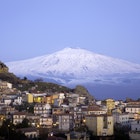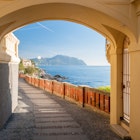
How to get around Sicily: scenic train rides, ferries and countryside drives

Mar 14, 2024 • 6 min read

From scenic train journeys along the coast to navigating public transportation within cities, here are some top tips for how to travel around Sicily © Oscar Wong / Getty Images
The 19th-century chestnut ‘The journey is the destination: really doesn’t do justice to the epic-scaled scenery that accompanies every trip in Sicily, big or small. This Italian island straddling three seas might be modest in size, but its varied landscapes are larger than life. Bus, boat, car, train or two wheels: however you get around, Sicily throws up stupendous coastline, mountain and volcano scenery in spades. Going slow is key – but even then, you’ll struggle to ingest a fraction of the natural grandeur en route.
Palermo and Catania – Sicily’s largest cities – are petite. And bewitching. Join locals for a morning mooch around an open-air food market or ritual passeggiata (afternoon stroll), and you’ll instantly understand why exploring on foot is the only sensible way to get under the skin of these chaotic, soul-stirring urban beauties. Offshore, on the back-to-basics Aeolian islands, it’s three-wheeled Ape taxis (Stromboli), posh electric golf carts (Panarea) and donkeys (Alicudi) that fly.

Rent a car to reach the island’s most remote corners
With world-famous sites such as Selinunte’s ancient Greek temples and Segesta’s must-see archaeological ruins tucked well away from any urban center, renting a car is the most convenient option. To explore the and mountains in the island’s remote interior or modern art marvels like Cretto di Buri tumbling down a hillside in the off-track Valle dei Belice, a car is a necessity. Ditto for wilder beaches, old-timer fishing villages, nature reserves and wineries on Sicily’s south-eastern tip and Ionian Coast.
Reserve wheels well in advance. Major car-rental agencies have desks at Palermo, Catania and Trapani airports. To rent wheels, you must be over 21 and possess a credit card. Driving licenses from EU member states are recognized, but drivers with licenses from elsewhere need an International Driving Permit.
Once on the road (always on the right), you’ll require nerves of steel. Even among Italians, Sicilians have a reputation for being the most unpredictable drivers in the country. Motorways (autostrada) and bigger secondary roads (SS/SP) are generally in good condition, but smaller roads can be pot-holed and poorly maintained. Tolls are charged on the A18 (Messina–Catania) and A20 (Messina–Palermo); have cash at hand in case the machine doesn’t like your card.
Planning Tip: Hire the smallest rental car you can to reduce the stress of squeezing your vehicle through impossibly narrow streets and into tight parking spaces.

Ride the rails for glorious views
Chugging along the Tyrrhenian Coast by train between Palermo, °ä±ð´Ú²¹±ôù, Messina and Milazzo, and south from Messina to Catania on the Ionian Coast is a breeze – with breathtaking sea views to boot.
Trains operated by Trenitalia are frequent, cheap and dependable. Advance reservations aren’t necessary on slower Regionale (RV) trains – seats aren’t numbered, and ticket prices don’t fluctuate on availability, unlike faster Intercity (IC) trains, which require a seat reservation. Buy tickets before your train departs via the Trenitalia website or app. Old-school paper tickets purchased at the ticket counters and machines in train stations still need to be validated at yellow machines on platforms before boarding.
Little beats the parallel Mt Etna, and big blue vistas aboard private trains that trundle in a 110km-long loop around the base of Sicily’s feisty volcano via a narrow-gauge track constructed in the 1890s. The twice-weekly service is hands down the best way to visit wineries on Etna’s fertile slopes. Buy tickets (well in advance in summer) via the FCE Catania or DropTicket apps.
Town-hop by bus to cruise on a budget
Getting into town from the airport will most likely be your first encounter with Sicilian buses. Away from rail-serviced coastal areas, buses are generally the best way to get around; for most small inland towns, they’re the only form of public transport. In rural areas, bus services often correspond with school hours and market times – which can mean leaving incredibly early or finding yourself stranded after mid-afternoon. Check Sunday schedules extra carefully, when services are virtually nonexistent.
Buses are operated by a mind-boggling array of companies, including Flixbus for several intercity routes. Check schedules on the Moovit app or consult schedules displayed in situ at the bus station.
Planning tip: Faster, more direct buses trump trains on certain routes: Palermo–Trapani, Palermo–Syracuse and Catania to/from Ragusa, Noto, Syracuse and Agrigento.

Sail to paradise in Sicily’s twinset archipelagos
It’s worth slotting western Sicily’s Egadi Islands or dreamy, UNESCO-recognized Aeolian Islands into your Sicilian itinerary, simply to sit back on a ferry or nippy hydrofoil in the Tyrrhenian Sea and admire tiny islands rising out of the cobalt-blue ocean.
Liberty Lines runs year-round hydrofoils to Favignana in the Egadi archipelago from the busy port of Trapani, and a handful to/from Marsala (better known for its honey-sweet dessert wine). Siremar operates slower car ferries.
Milazzo port is the launchpad for Liberty Lines hydrofoils to the largest Aeolian island Lipari, and beyond to its six smaller but equally charismatic sisters. Cheaper, slower ferries – limited space for cars so book well ahead – sail the same route. Inter-island sailings are most frequent from June to September; boats fill fast in July and August. Save queueing at Liberty Lines ticket offices by buying tickets online.
Once on your paradise island, private boat taxis are handy for accessing remote caves and hidden turquoise coves. Simply look for handwritten notes with mobile numbers pinned up by local fishermen and boatmen in island shops, bakeries and at ports. And remember: little beats the romance of a sunset aperitivo in barca (drinks afloat).
Zip around on two wheels
In urban Palermo, public sharing bikes and e-bikes (both operated by – download the app to locate, pay for and unlock wheels) and free-floating e-scooters run by a fleet of operators make light work of longer distances. In Catania, download the app to access shared e-bikes.
Further afield, road cycling – traditional and electric-assisted – is an exhilarating means of the island’s twisting backcountry and coastal roads. Roads inland can be steep and precarious, meaning bike shops offering rental and guided bike tours are most rife on the coast: in Syracuse, rent all manner of bicycles and hook up with guides at to explore sea caves, medieval villages and the prized amphitheater where Greek playwright Aeschylus watched his tragedies unfold in the 5th century BC. The cinematic slopes of Mount Etna and nearby gorges of Alcantara are popular with mountain bikers ( arranges guided MTB tours), and on the Aeolian islands, Lipari is a mountain-biking hub.
Romantics aspiring to view Sicily from the back of a Vespa Audrey Hepburn-style can live the dream on Lipari and Salina – the two Aeolian islands with motorized traffic. Book 50cc and 125cc scooters ahead of arrival; scooters are snapped up fast in high season. Bring your driving license to rent wheels up to 125cc; anything over 125cc requires a motorcycle license. Helmets are provided and are required by law, despite the fact most Sicilians don’t wear them.

Accessible transportation in Sicily
Sicily is definitely not plain sailing for people with a disability. While some trains and buses are accessible to wheelchairs, cobbled streets in towns, narrow or crumbling pavements and hectic urban traffic are most definitely not. Some beaches are barrier-free. Sicilian airports, Liberty Lines boats and Trenitalia trains all provide assistance for passengers with reduced mobility, hearing or visual impairments.
For more information, consult online guides at and Ïã¸ÛÁùºÏ²Ê¼´Ê±¿ª½±â€™s accessible travel .
Explore related stories

Destination Practicalities
How to travel around Italy: everything you need to know about driving, cycling and public transportMay 30, 2023 • 14 min read








